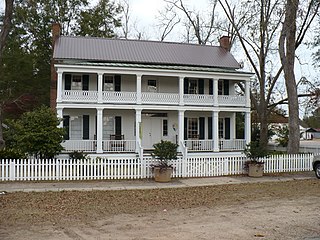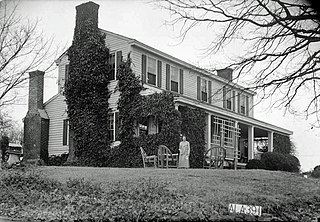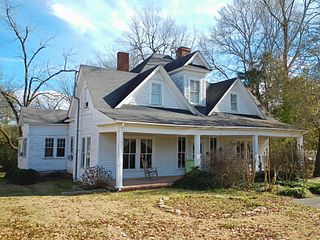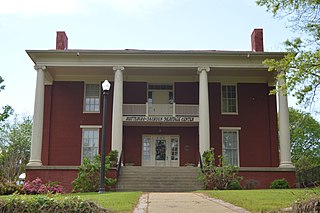
The dogtrot, also known as a breezeway house, dog-run, or possum-trot, is a style of house that was common throughout the Southeastern United States during the 19th and early 20th centuries. Some theories place its origins in the southern Appalachian Mountains. Some scholars believe the style developed in the post-Revolution frontiers of Kentucky and Tennessee. Others note its presence in the South Carolina Lowcountry from an early period. The main style point was a large breezeway through the center of the house to cool occupants in the hot southern climate.

The Alston–Cobb House, now formally known as the Clarke County Historical Museum, is a historic house and local history museum in Grove Hill, Alabama. It was built in 1854 by Dr. Lemuel Lovett Alston as a Greek Revival I-house, a vernacular style also known in the South as Plantation Plain. It is one of only four examples of an I-house to survive intact in Clarke County. The Alston–Cobb House was added to the Alabama Register of Landmarks and Heritage on September 1, 1978, and to the National Register of Historic Places on April 30, 1979.

Altwood is a historic plantation house located near Faunsdale, Alabama. It was built in 1836 by Richard H. Adams and began as a log dogtrot house. It was then expanded until it came to superficially resemble a Tidewater-type cottage. Brought to the early Alabama frontier by settlers from the Tidewater and Piedmont regions of Virginia, this vernacular house-type is usually a story-and-a-half in height, displays strict symmetry, and is characterized by prominent end chimneys flanking a steeply pitched longitudinal gable roof that is often pierced by dormer windows.

Roseland Plantation is a historic plantation complex site in Faunsdale, Alabama. The site is situated on a low hill at the end of a long driveway on the overgrown estate. It was added to the National Register of Historic Places on January 20, 1994, as a part of the Plantation Houses of the Alabama Canebrake and Their Associated Outbuildings Multiple Property Submission.

The William King Beck House, also known as River Bluff Plantation, is a historic plantation house on the Alabama River near Camden, Alabama. The main house was built in 1845 for William King Beck and is attributed to architect Alexander J. Bragg. William King Beck was an attorney from North Carolina who migrated to Wilcox County in the 1820s. He was the nephew of William Rufus King, the 13th Vice President of the United States.

Bermuda Hill, also known as the Liver House, is a historic plantation house in Hale County, Alabama, near Prairieville, Alabama. It was added to the National Register of Historic Places on July 7, 1994, as a part of the Plantation Houses of the Alabama Canebrake and Their Associated Outbuildings Multiple Property Submission.

Fairhope Plantation is a historic Carpenter Gothic plantation house and historic district, located one mile east of Uniontown, Alabama, US. The 2+1⁄2-story wood-framed main house was built in the Gothic Revival style in the late 1850s. The plantation historic district includes six other contributing buildings, in addition to the main house. It was added to the Alabama Register of Landmarks and Heritage on December 19, 1991, and subsequently to the National Register of Historic Places on May 29, 1992, due to its architectural and historical significance.

The Ashville Historic District in Ashville, Alabama is a historic district that was listed on the National Register of Historic Places in 2005. In 2005, it included 122 contributing buildings plus one other contributing site and one other contributing object.

The James Greer Bankhead House, also known simply as the Greer Bankhead House and Forest Home, is a historic house in Sulligent, Alabama. It was added to the National Register of Historic Places on February 13, 1975. It is the only site listed on the National Register in Lamar County.
The Bryand Brand House is a historic plantation house on the east side of Alabama State Route 14 near Marion, Perry County, Alabama. The two-story Greek Revival style house was built in 1845. Unique features of the interior are the treatment of the wide central hall as a quasi-dogtrot, the double-leaf front door, and the original rabbeted sheathing found on all of the ceilings and on the walls of the central halls. The house was moved to its current site in 1978 to save it from destruction. It was added to the National Register of Historic Places on June 22, 2010.

The John Morgan House is a historic house in Heflin, Alabama. The house was built circa 1880 by John Francis and Louise Perryman Morgan, on land given to John for his service in the Mexican–American War. After Heflin was incorporated in 1892, Morgan was elected its first mayor.

The Asa Johnston Farmhouse is a historic farmhouse in Johnstonville, Conecuh County, Alabama. The one story, spraddle roof dogtrot house was built in 1842 by Ezra Plumb for Asa Johnston.

Cherokee Plantation is a historic house in Fort Payne, Alabama. The house was built in 1790 as a two-story log cabin by Andrew Ross, a judge on the Cherokee Supreme Court and brother of Principal Chief John Ross. In 1834 a second log cabin was built connected to the rear of the original cabin, and a third was built to the northeast, separated by a breezeway. Ross, being one-eighth Cherokee, was forced to leave his home in 1838 under the provisions of the Treaty of New Echota, of which Ross was a signatory; a portion of the Cherokee Trail of Tears passes in front of the house.

The Dr. James J. Bothwell House, also known as Bothwell-Embry House, is a historic residence in Ashville, Alabama. The house was built in 1835 for James Bothwell, the second doctor in Ashville, and also a clerk of the circuit court. It is a two-story Federal-style house, with a two-story pedimented portico supported by four Doric columns. In 1852 a wing was added to the rear of the house for a kitchen and dining room on the ground floor and a bedroom above. Another ground floor bedroom wing was added in 1882. Another bedroom was added above in 1917, and the area between the wings was enclosed. The house was listed on the Alabama Register of Landmarks and Heritage in 1979 and the National Register of Historic Places in 1982. It is to be sold at auction in May 2014.

The Urquhart House is a historic residence in Huntsville, Alabama. The property was acquired by Allen Urquhart in 1813, and the house was built soon after. The dogtrot house was built in several phases, with the eastern "pen" being the original section. It was originally built as a one-room log house with a 7-foot (2.1-meter) ceiling. The house was extensively modified around 1835; the ceiling was raised to 9 feet 2 inches (2.79 m), and many Federal-period details were added, including beaded chair rails and baseboards, an elaborate mantle, and lath and plastered walls. The second floor and western pen may have been added at this time; most of the original details were removed from the western pen in the early 20th century, making it difficult to date its construction. When it was completed, the house's dogtrot form was established, including loft rooms over both pens and the breezeway. An addition was made in the 1860s or 1870s to the rear of the western pen which features a Greek Revival mantle. In circa 1915–1930, a kitchen was added to the rear of this room, and an enclosed porch was built in the ell along the rear of the house. A front porch was added in the middle of the 20th century.

The Jude–Crutcher House is a historic plantation house in Huntsville, Alabama. The house was built circa 1812 on land deeded that year to Samuel Echols. Echols sold 54 acres and the house to George Jude, Sr., in 1817. Jude died two years later, leaving the land to his son, George Jr. The younger Jude eventually acquired 800 acres and owned 31 slaves. Upon his death in 1873, the land stayed in the family until 1883. In 1906 David Crutcher, who had been born a slave on an adjacent plantation in 1851, purchased the house and 154 acres along with two other African-American men. The Crutchers operated a successful farm on their portion of the land, which was an extension farm for Alabama A&M University until the 1940s. Only 7% of African-American farmers in Madison County in 1910 owned their own farms. David died in 1924, and his wife, Lucy, died in 1943, although the house and land is still in the family.

The Brown–Proctor House is a historic residence in Scottsboro, Alabama. The house was built in 1881 by John A. Brown, who sold it just one year later. He sold the house to General Coffey, who bought the house for his daughter Sarah, for 3,200 dollars. John Franklin Proctor, a politician who served in the Alabama Legislature from 1892 through 1899 and was an attorney for the Scottsboro Boys in 1931, purchased the house in 1907. Proctor made numerous renovations to the house, including altering the two-story front portico with Tuscan columns into its current state of a single-level porch supported by Ionic columns with a central second floor balcony. A three-room addition was also built onto the back of the house, adding to the central hall plan of the original house. After his death in 1934, Proctor's family owned the house until 1981.

The Thomas Holland House was a historic residence near Hillsboro, Alabama. The house was built around 1836 by Thomas Holland, a South Carolinian who had come to Lawrence County, Alabama, in 1823. Holland began his plantation with 40 acres and built it to over 2100 acres by 1849. The house was a full two-story dogtrot house constructed of logs, one of the only of its type in Alabama. The exterior had since been covered in clapboard, and the breezeway had been finished with vertical boards and a chair rail. Enclosed stairways in each lower room gave access to the upper floor; the central room over the dogtrot was only accessible from the eastern room. The house was listed on the Alabama Register of Landmarks and Heritage and the National Register of Historic Places in 1991.

The John Daniel Rather House is a historic residence in Tuscumbia, Alabama. The house was built in 1823 by William H. and Catherine Winter, who came to The Shoals from Prince William County, Virginia. It was taken over by the Union Army during the Civil War and used as the headquarters of General Florence M. Cornyn. After the war, the house was purchased by John Taylor Rather, an early North Alabama settler who was deputy sheriff of Madison County, and a longtime member of the Alabama House of Representatives and later the Alabama Senate. His son, John Daniel Rather, also served in both houses of the state legislature, and was President of the Memphis and Charleston Railroad.

The Judge Elisha Robinson House, in Ashville, Alabama, is a Queen Anne-style house built around 1890. It was listed on the National Register of Historic Places in 1991.























